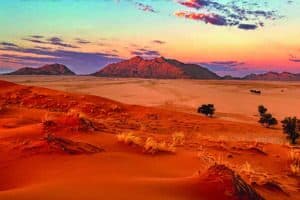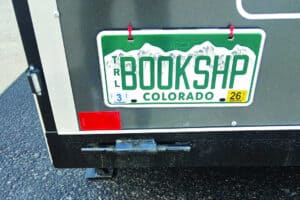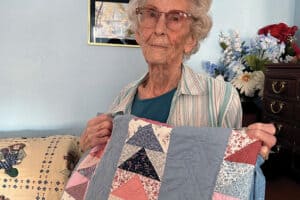Renowned artist, Rusty Phelps, is a man who proudly sticks to what he knows. And what he knows is a world that is western and wild.†Phelps is a fourth generation native Coloradan who lives in Black Forest on the same land that his grandfather once homesteaded in 1878. He comes from a long line of hardworking cowboys and ranchers. Phelpsí grandfather was an old-time cowboy from Texas who grew up cowboying for his father (Phelpsí great grandfather). Later in life after the end of WWII, Phelpsí father ranched in Black Forest with his brother (Phelpsí uncle). Naturally, Rusty Phelps also worked on ranches, helping on his familyís ranch and neighboring ranches, and picking up day work on various ranches throughout his life.Phelps said, ìMy granddad, he used to tell stories about the Old West and the cowboys Ö and when you have that kind of influence on you, you ainít gonna go anywhere else. If I could find a ranch that needed help, then thatís where I went to work because thatís the thing I knew best.îPhelps also has experience as a lifelong hunter, as well as a guide for a big game outfitter. ìI also owned a taxidermy shop and have been involved in firearms and wildlife organizations and such,î he said.†Marketed under Phelps Western Wildlife Art, Phelps artwork ties back to his extensive, hands-on background in wildlife and the western lifestyle. ìThe subject matter of my art ó Iíve never varied from that. Iíve always wanted to do horses, and cowboys, and Indians, and buffalo, and deer and elk,î Phelps said.And the story of his love for art itself goes back much further than that.†Phelps was born in Colorado Springs at Beth-El Hospital (what is now Memorial Hospital). Shortly after, his family moved to northern California where his father tried to make a better living at the gold mines. At the age of 3, Phelps contracted bronchial pneumonia, which he said crippled him for about a year. He recalled his mother telling stories of how during that time, young Phelps couldnít play outside with the other kids, so he would stay inside and draw on the familyís cabin walls with a piece of crayon. ìI started then and I never quit,î he said, referring to creating art.†But it certainly wasnít a straight path from there to becoming a professional artist. Actually, it wasnít until Phelps was in his 30s ó after eight years of serving in the U,S. Navy; honorably discharged in 1963; providing for his family through various odd jobs; and then waiting for the GI bill to come back into effect ó that he enrolled at the University of Colorado at Colorado Springs and unexpectedly ended up studying art. He said, ìI went to college originally to become a game warden, but my art professor said, ëYou would be a better artist than you would be anything else.í He said I should try to make my career out of art. So, I did.îPhelps credits a great deal of his success to that professor. The professor, primarily a modern artist and not knowing much about the type of western and wildlife art that Phelps was interested in, sent him to Taos, New Mexico. There was a foundry where he could produce countless sculptures and, more importantly, where he would be immersed in a culture brimming with talent and artwork comparable to his own.†ìThat professor encouraged me. He just knew that my type of art ó western and wildlife art ó thatís the kind of art you could find in Taos. To associate with the kind of people that did the kind of work that I did, that was the place to go,î Phelps said. The professor went so far as to tell Phelps to not worry about attending class. He just wanted Phelps to produce as much art as possible, then bring it to class at the semesterís end to be graded. ìHe always just gave me a passing grade,î Phelps said.Much like studying art was an accident, so was the day Phelps officially considered himself a professional artist.††ìOne day, in 1970, two fellas knocked on my door. They were very wealthy people and they showed up and wanted to buy every single piece of art that I had ó and I had a lot of it,î Phelps said.ìThey took it and said they would be back for more and to just keep on producing. That was the day I went from amateur to professional. They sold everything that I had for the next 20 years, everything I could produce.îFrom that point on, Phelps primarily made his living as a sculptor. He worked with bronze as his preferred material and has never stopped to count how many hundreds of pieces he has created and sold.†His artwork has been sent all over the world ó across the United States, Asia, Europe, Mexico, Canada and more. He has sculpted for presidents, congressmen, generals, and other noteworthy people, too.†Even the Prince of Saudi Arabia has more than 20 of his pieces, Phelps said.†Several of his works can be found around the Colorado Springs area ó his art is displayed at the U.S. Air Force Academy. He said, ìIf someone donated a million dollars to the Air Force Academy for their athletic program, then they hired me to do a sculpture of them.î Phelps would create these sculptures on one condition: that he got to meet with the subject personally, face-to-face beforehand. ìIíve got to meet them first, really get to know them, in order to do an honest sculpture of them. And right now, the academy is full of them. Theyíve got a lot of my sculptures.î†In addition to creating art for so many important people and causes, Phelps has also received many accolades over the years, such as the gold, silver and bronze awards at the Western Heritage Art Show in Littleton, Colorado; the silver award at the George Phippens Memorial in Prescott, Arizona; and first place at the Northern Wildlife Art Expo in Lansing, Michigan.†For Phelps, though, the recognition, awards and money have never been his motivators. ìIíve always done my art, not to make a living necessarily. . . I never gave that a lot of thought. I do what I do because I love to do it. And if I make a living at it or sell a piece, then good for me, but if I donít then Iím not worried about it,î he said.Today, Phelps sticks to his western and wildlife roots (and always will), but now reckons himself a painter rather than a sculptor.†He said, ìI paint now because I love to paint. Iím 86 years old, and Iím not trying to set the world on fire. There ain’t many people now that want a picture of a bull elk in their living room. But I take what I can get.î†






